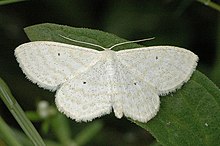| Scopula immutata | |
|---|---|

| |
| Scientific classification | |
| Domain: | Eukaryota |
| Kingdom: | Animalia |
| Phylum: | Arthropoda |
| Class: | Insecta |
| Order: | Lepidoptera |
| Family: | Geometridae |
| Genus: | Scopula |
| Species: | S. immutata |
| Binomial name | |
| Scopula immutata (Linnaeus, 1758) | |
| Synonyms | |
| |
Scopula immutata, the lesser cream wave, is a moth of the family Geometridae. It was described by Carl Linnaeus in his 1758 10th edition of Systema Naturae. It is found throughout Europe.
Distribution
A typical temperate to boreal Palearctic species. In Europe it ranges from the west coast of France and the British Isles to the Urals. In the north it extends from central Scandinavia, south to central Italy and south Bulgaria. This latter occurrence is isolated from the main populations and is limited to higher regions. There are also isolated, very much small occurrences in northern Portugal and north-eastern Spain, as well as evidence in Corsica and Sardinia. However, these findings must still be confirmed. Outside Europe the species spreads east across the Caucasus, Kazakhstan, southern Siberia, Mongolia and the Russian Far East and Sakhalin.
The species is moisture loving and is therefore found in humid forests, swamps, bogs, wet meadows and along rivers. In the Alps and southern Europe it rises up to 1,200 metres (3,900 ft), rarely even higher (max. 1,850 meters).
Description
The wingspan is 24–27 millimetres (0.94–1.06 in). The length of the forewings is 12–13 millimetres (0.47–0.51 in). The second generation in the south and moths in the north of the range can reach only 19–23 millimetres (0.75–0.91 in). The ground colour is silk white with yellow dusting of varying intensity (particularly in the males). Drought and high temperatures during the development of the pupae induce more yellowish moths with pronounced pattern. The wavy crosslines are yellowish, ochreous to light brown in colour (with a fine scattering of black scales). Typically there are four crosslines and a wavy marginal line (often wide and blurred). Discal flecks are always present, but they can be much weaker on the front wings. Marginal stains are occasional, and then quite small and inconspicuous. See also Prout. It is similar to Scopula floslactata, but can be distinguished by its more rounded forewings and black discal spot.
The egg is almost perfectly cylindrical, the ends only slightly rounded with about 15 powerful longitudinal ribs, the transverse ribs exceedingly fine and about 15-18 in number. It is delicate greenish-yellow, becoming after 2 days pale pink with scattered crimson spots. The larva is rather slender, nearly cylindrical, tapering towards the head, the subsegmentation distinct; grey-brown with fine pale medio-dorsal line, its fine dark edges thickened into black dashes at the ends of the segments; an ill-defined dark supra-spiracular line and a rather pale lateral stripe containing the black spiracles. The pupa is pale brown with the wing-cases more greenish.
The moth flies in one generation from June to August in western Europe.

The larvae feed on meadowsweet and valerian. The moth sits by day among rank grass and is easily disturbed.
References
- Sihvonen, Pasi (April 1, 2005). "Phylogeny and classification of the Scopulini moths (Lepidoptera: Geometridae, Sterrhinae)". Zoological Journal of the Linnean Society. 143 (4): 473–530. doi:10.1111/j.1096-3642.2005.00153.x.
- "Scopula (Calothysanis) immutata (Linnaeus, 1758)". Fauna Europaea. 2.6.2. 29 August 2013. Archived from the original on November 23, 2015. Retrieved 18 April 2017.
- Prout, L. B. (1912–16). Geometridae. In A. Seitz (ed.) The Macrolepidoptera of the World. The Palaearctic Geometridae, 4. 479 pp. Alfred Kernen, Stuttgart.pdf
 This article incorporates text from this source, which is in the public domain.
This article incorporates text from this source, which is in the public domain.
External links
- Kimber, Ian. "70.025 BF1692 Lesser Cream Wave Scopula immutata (Linnaeus, 1758)". UKMoths. Retrieved 11 July 2020.
- Lepiforum e. V.
- Vlindernet.nl (in Dutch)
| Taxon identifiers | |
|---|---|
| Scopula immutata |
|